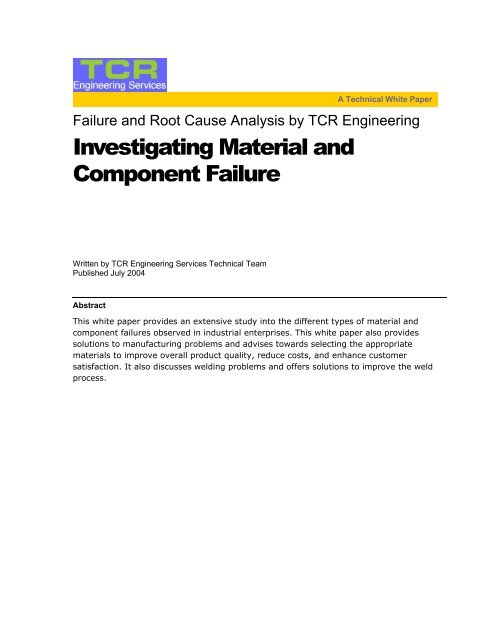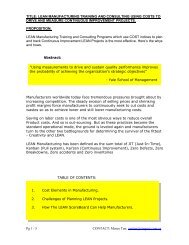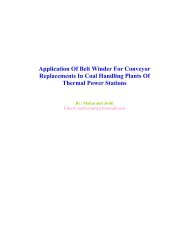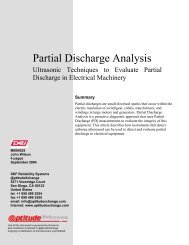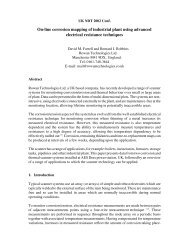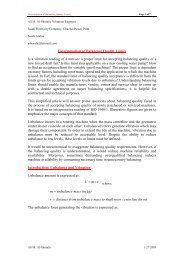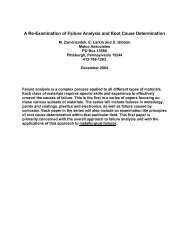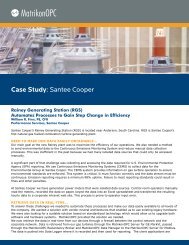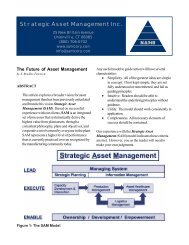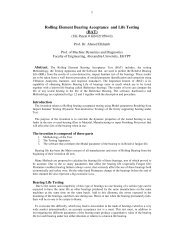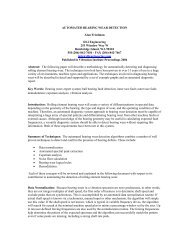Investigating Material and Component Failure - TCR Engineering ...
Investigating Material and Component Failure - TCR Engineering ...
Investigating Material and Component Failure - TCR Engineering ...
You also want an ePaper? Increase the reach of your titles
YUMPU automatically turns print PDFs into web optimized ePapers that Google loves.
A Technical White Paper<br />
<strong>Failure</strong> <strong>and</strong> Root Cause Analysis by <strong>TCR</strong> <strong>Engineering</strong><br />
<strong>Investigating</strong> <strong>Material</strong> <strong>and</strong><br />
<strong>Component</strong> <strong>Failure</strong><br />
Written by <strong>TCR</strong> <strong>Engineering</strong> Services Technical Team<br />
Published July 2004<br />
Abstract<br />
This white paper provides an extensive study into the different types of material <strong>and</strong><br />
component failures observed in industrial enterprises. This white paper also provides<br />
solutions to manufacturing problems <strong>and</strong> advises towards selecting the appropriate<br />
materials to improve overall product quality, reduce costs, <strong>and</strong> enhance customer<br />
satisfaction. It also discusses welding problems <strong>and</strong> offers solutions to improve the weld<br />
process.
The information contained in this document represents the current view of <strong>TCR</strong> <strong>Engineering</strong> Services Pvt. Ltd.<br />
(<strong>TCR</strong>) on the issues discussed as of the date of publication. Because <strong>TCR</strong> must respond to changing market<br />
conditions, it should not be interpreted to be a commitment on the part of <strong>TCR</strong>, <strong>and</strong> <strong>TCR</strong> cannot guarantee the<br />
accuracy of any information presented after the date of publication.<br />
This White Paper is for informational purposes only. <strong>TCR</strong> MAKES NO WARRANTIES, EXPRESS OR IMPLIED,<br />
AS TO THE INFORMATION IN THIS DOCUMENT.<br />
Complying with all applicable copyright laws is the responsibility of the user. Without limiting the rights under<br />
copyright, no part of this document may be reproduced, stored in or introduced into a retrieval system, or<br />
transmitted in any form or by any means (electronic, mechanical, photocopying, recording, or otherwise), or for<br />
any purpose, without the express written permission of <strong>TCR</strong>.<br />
<strong>TCR</strong> may have patents, patent applications, trademarks, copyrights, or other intellectual property rights covering<br />
subject matter in this document. Except as expressly provided in any written license agreement from Microsoft,<br />
the furnishing of this document does not give you any license to these patents, trademarks, copyrights, or other<br />
intellectual property.<br />
The example companies, organizations, products, people <strong>and</strong> events depicted herein are fictitious. No<br />
association with any real company, organization, product, person or event is intended or should be inferred.<br />
© 2004 <strong>TCR</strong> All rights reserved.<br />
The names of actual companies <strong>and</strong> products mentioned herein may be the trademarks of their respective<br />
owners.
CONTENTS<br />
INTRODUCTION ...........................................................................................................1<br />
TYPICAL ROOT CAUSE METALLURGICAL FAILURE MECHANISMS ...........................2<br />
Fatigue <strong>Failure</strong>s 2<br />
Corrosion <strong>Failure</strong>s 2<br />
Uniform Corrosion 3<br />
Pitting Corrosion 3<br />
Crevice Corrosion 3<br />
Galvanic Corrosion 4<br />
Stress Corrosion Cracking 4<br />
Ductile <strong>and</strong> Brittle Metal <strong>Failure</strong>s 5<br />
Hydrogen Embrittlement <strong>Failure</strong>s 5<br />
Liquid Metal Embrittlement <strong>Failure</strong>s 6<br />
High Temperature <strong>Failure</strong>s 6<br />
CASTING FAILURE ANALYSIS.....................................................................................7<br />
BOILER FAILURES .......................................................................................................8<br />
HEAT EXCHANGER FAILURE.......................................................................................9<br />
PRESSURE VESSEL FAILURE ....................................................................................10<br />
PIPELINE FAILURE ....................................................................................................11<br />
LIFTING EQUIPMENT FAILURES ...............................................................................12<br />
FASTENER FAILURES................................................................................................13<br />
GEAR FAILURES ........................................................................................................14<br />
ROLLER AND BALL BEARINGS..................................................................................15<br />
SHAFT FAILURES.......................................................................................................16<br />
CHEMICAL PLANT CORROSION ................................................................................17<br />
PULP AND PAPER INDUSTRY CORROSION ..............................................................18<br />
FOOD PROCESSING EQUIPMENT FAILURES ............................................................19<br />
SHIP FAILURES..........................................................................................................20
WELD FAILURE ANALYSIS ........................................................................................21<br />
MIG Welding 21<br />
TIG Welding 22<br />
Stick Welding 22<br />
Submerged Arc Welding 23<br />
ROOT CAUSE ANALYSIS ...........................................................................................24<br />
Analysis Procedure 24<br />
Preventing Reoccurrence of the <strong>Failure</strong> 24<br />
ABOUT <strong>TCR</strong> ENGINEERING SERVICES .....................................................................25<br />
<strong>Failure</strong> Analysis Team 25
INTRODUCTION<br />
<strong>Failure</strong> analysis is an engineering approach to determining how <strong>and</strong> why<br />
equipment or a component has failed. Some general causes for failure are<br />
structural loading, wear, corrosion, <strong>and</strong> latent defects. The goal of a failure<br />
analysis is to underst<strong>and</strong> the root cause of the failure so as to prevent similar<br />
failures in the future.<br />
In addition to verifying the failure mode it is important to determine the factors<br />
that explain the “how <strong>and</strong> why” of the failure event. Identifying the root cause of<br />
the failure event allows us to explain the “how <strong>and</strong> why” of failure.<br />
Common causes of failure include:<br />
• Misuse or Abuse<br />
• Assembly errors<br />
• Manufacturing defects<br />
• Improper maintenance<br />
• Fastener failure<br />
• Design errors<br />
• Improper material<br />
• Improper heat treatments<br />
• Unforeseen operating conditions<br />
• Inadequate quality assurance<br />
• Inadequate environmental protection/control<br />
• Casting discontinuities<br />
Whether a product defect is due to a forging, casting, or welding defect a failure<br />
investigation can identify the root cause of the failure <strong>and</strong> determine the<br />
pertinent structural defect that caused the failure.<br />
<strong>Failure</strong> investigation are performed by <strong>TCR</strong> <strong>Engineering</strong> Services on bearing,<br />
bridge, valve, bolt, boiler, gear, shaft, fastener, tank, medical devices, <strong>and</strong>/or<br />
other industrial or consumer products.<br />
The technical staff at <strong>TCR</strong> has performed manufacturing or metallurgical failure<br />
analysis on ASME boiler <strong>and</strong> pressure vessels, Aircraft /Aerospace, Gas turbine<br />
engine components, Oil <strong>and</strong> gas transmission pipelines, Food processing<br />
equipments, Heat exchangers, Medical supplies, Automotive components,<br />
Refineries, Petrochemical plants, Offshore structures, Industrial machinery,<br />
Weldments <strong>and</strong> Ships.<br />
<strong>Failure</strong> <strong>and</strong> Root Cause Analysis White Paper by <strong>TCR</strong> <strong>Engineering</strong>, India 1
TYPICAL ROOT CAUSE METALLURGICAL FAILURE MECHANISMS<br />
Fatigue <strong>Failure</strong>s<br />
Metal fatigue is caused by repeated cycling of the load below its static yield<br />
strength. It is a progressive localized damage due to fluctuating stresses <strong>and</strong><br />
strains on the material. Metal fatigue cracks initiate <strong>and</strong> propagate in regions<br />
where the strain is most severe. The process of fatigue consists of three stages -<br />
Initial crack initiation, Progressive crack growth across the part, <strong>and</strong> Final sudden<br />
fracture of the remaining cross section.<br />
Because most engineering materials contain discontinuities most metal fatigue<br />
cracks initiate from discontinuities in highly stressed regions of the component.<br />
The failure may be due to the discontinuity, design, improper maintenance or<br />
other causes.<br />
The most effective method of improving fatigue performance <strong>and</strong> preventing<br />
failure is by making improvements in design:<br />
• Eliminate or reduce stress raisers by streamlining the part<br />
• Avoid sharp surface tears resulting from punching, stamping, shearing, or<br />
other processes<br />
• Prevent the development of surface discontinuities during processing.<br />
• Reduce or eliminate tensile residual stresses caused by manufacturing.<br />
• Improve the details of fabrication <strong>and</strong> fastening procedures<br />
Corrosion <strong>Failure</strong>s<br />
Corrosion is chemically induced damage to a material that results in deterioration<br />
of the material <strong>and</strong> its properties. This may result in failure of the component.<br />
Several factors should be considered during a failure analysis to determine the<br />
affect corrosion played in a failure. Examples are listed below:<br />
• Type of corrosion<br />
• Corrosion rate<br />
• The extent of the corrosion<br />
• Interaction between corrosion <strong>and</strong> other failure mechanisms<br />
Corrosion is a normal, natural process. Corrosion can seldom be totally<br />
prevented, but it can be minimized or controlled by proper choice of material,<br />
design, coatings, <strong>and</strong> occasionally by changing the environment. Various types<br />
of metallic <strong>and</strong> nonmetallic coatings are regularly used to protect metal parts<br />
from corrosion. Identification of the metal or metals, environment the metal was<br />
subjected to, foreign matter <strong>and</strong>/or surface layer of the metal is beneficial in<br />
failure determination.<br />
<strong>Failure</strong> <strong>and</strong> Root Cause Analysis White Paper by <strong>TCR</strong> <strong>Engineering</strong>, India 2
Uniform Corrosion<br />
Uniform or general corrosion is typified by the rusting of steel. Other<br />
examples of uniform corrosion are the tarnishing of silver or the green patina<br />
associated with the corrosion of copper.<br />
General corrosion is rather predictable. The life of components can be<br />
estimated based on relatively simple immersion test results. Allowance for<br />
general corrosion is relatively simple <strong>and</strong> commonly employed when<br />
designing a component for a known environment.<br />
Some common methods used to prevent or reduce general corrosion are<br />
Coatings, Inhibitors, Cathodic protection <strong>and</strong> Proper materials selection.<br />
Pitting Corrosion<br />
Pitting is a localized form of corrosive attack. Pitting corrosion is typified by<br />
the formation of holes or pits on the metal surface. Pitting can cause failure<br />
due to perforation while the total corrosion, as measured by weight loss,<br />
might be rather minimal. The rate of penetration may be 10 to 100 times<br />
that by general corrosion.<br />
Pits may be rather small <strong>and</strong> difficult to detect. In some cases pits may be<br />
masked due to general corrosion. Pitting may take some time to initiate <strong>and</strong><br />
develop to an easily viewable size.<br />
Pitting occurs more readily in a stagnant environment. The aggressiveness of<br />
the corrodent will affect the rate of pitting. Some methods for reducing the<br />
effects of pitting corrosion are listed below:<br />
• Reduce the aggressiveness of the environment<br />
• Use more pitting resistant materials<br />
• Improve the design of the system<br />
Crevice Corrosion<br />
Crevice corrosion is a localized form of corrosive attack. Crevice corrosion<br />
occurs at narrow openings or spaces between two metal surfaces or between<br />
metals <strong>and</strong> nonmetal surfaces. A concentration cell forms with the crevice<br />
being depleted of oxygen. This differential aeration between the crevice<br />
(microenvironment) <strong>and</strong> the external surface (bulk environment) gives the<br />
crevice an anodic character. This can contribute to a highly corrosive<br />
condition in the crevice such as Flanges, Deposits, Washers, Rolled tube ends,<br />
Threaded joints, O-rings, Gaskets, Lap joints <strong>and</strong>/or Sediments.<br />
Some methods for reducing the effects of crevice corrosion are listed below:<br />
• Eliminate the crevice from the design<br />
• Select materials more resistant to crevice corrosion<br />
• Reduce the aggressiveness of the environment<br />
<strong>Failure</strong> <strong>and</strong> Root Cause Analysis White Paper by <strong>TCR</strong> <strong>Engineering</strong>, India 3
Galvanic Corrosion<br />
Galvanic corrosion is frequently referred to as dissimilar metal corrosion.<br />
Galvanic corrosion can occur when two dissimilar materials are coupled in a<br />
corrosive electrolyte. An illustration of galvanic corrosion would be joining<br />
two dissimilar metals in electrical contact in seawater.<br />
In a galvanic couple, one of the metals in the couple becomes the anode <strong>and</strong><br />
the other metal becomes the cathode. The less noble material becomes the<br />
anode. The anodic metal corrodes faster than it would all by itself. The<br />
cathodic metal corrodes slower than it would all by itself.<br />
Many boaters use this knowledge to their benefit. Sacrificial zinc anodes are<br />
commonly used to protect metal components on boats. The zinc anode<br />
corrodes preferentially there by protecting the boat component. The zinc<br />
anodes are maintained <strong>and</strong> replaced as required to insure continued<br />
protection. Other alloys are also used as sacrificial anodes. Aluminum or<br />
magnesium sacrificial anodes provide better protection in some cases.<br />
Stress Corrosion Cracking<br />
Stress corrosion cracking is a failure mechanism that is caused by<br />
environment, susceptible material, <strong>and</strong> tensile stress. Temperature is a<br />
significant environmental factor affecting cracking. Aluminum <strong>and</strong> stainless<br />
steel are well known for stress corrosion cracking problems. However, all<br />
metals are susceptible to stress corrosion cracking in the right environment.<br />
For stress corrosion cracking to take place all three conditions must be met<br />
simultaneously - The component needs to be in a particular crack promoting<br />
environment, the component must be made of a susceptible material, <strong>and</strong><br />
there must be tensile stresses above some minimum threshold value. An<br />
externally applied load is not required as the tensile stresses may be due to<br />
residual stresses in the material. The threshold stresses are commonly below<br />
the yield stress of the material.<br />
Stress corrosion cracking is an insidious type of failure as it can occur without<br />
an externally applied load or at loads significantly below yield stress. Thus,<br />
catastrophic failure can occur without significant deformation or obvious<br />
deterioration of the component. Pitting is commonly associated with stress<br />
corrosion cracking phenomena.<br />
There are several methods to prevent stress corrosion cracking. One common<br />
method is proper selection of the appropriate material. A second method is to<br />
remove the chemical species that promotes cracking. Another method is to<br />
change the manufacturing process or design to reduce the tensile stresses.<br />
<strong>TCR</strong> can provide engineering expertise to prevent or reduce the likelihood of<br />
stress corrosion cracking in your components.<br />
<strong>Failure</strong> <strong>and</strong> Root Cause Analysis White Paper by <strong>TCR</strong> <strong>Engineering</strong>, India 4
Ductile <strong>and</strong> Brittle Metal <strong>Failure</strong>s<br />
Ductile metals experience observable plastic deformation prior to fracture.<br />
Brittle metals experience little or no plastic deformation prior to fracture. At<br />
times metals behave in a transitional manner - partially ductile/brittle.<br />
Ductile fracture is characterized by tearing of metal <strong>and</strong> significant plastic<br />
deformation. The ductile fracture may have a gray, fibrous appearance.<br />
Ductile fractures are associated with overload of the structure or large<br />
discontinuities.<br />
Ductile fracture has dimpled, cup <strong>and</strong> cone fracture appearance. The dimples<br />
can become elongated by a lateral shearing force, or if the crack is in the<br />
opening (tearing) mode.<br />
Brittle fracture is characterized by rapid crack propagation with low energy<br />
release <strong>and</strong> without significant plastic deformation. The fracture may have a<br />
bright granular appearance. The fractures are generally of the flat type <strong>and</strong><br />
chevron patterns may be present.<br />
Brittle fracture displays either cleavage (transgranular) or intergranular<br />
fracture. This depends upon whether the grain boundaries are stronger or<br />
weaker than the grains.<br />
The fracture modes (dimples, cleavage, or intergranular fracture) may be<br />
seen on the fracture surface <strong>and</strong> it is possible all three modes will be present<br />
of a given fracture face.<br />
Hydrogen Embrittlement <strong>Failure</strong>s<br />
When tensile stresses are applied to hydrogen embrittled component it may<br />
fail prematurely. Hydrogen embrittlement failures are frequently unexpected<br />
<strong>and</strong> sometimes catastrophic. An externally applied load is not required as the<br />
tensile stresses may be due to residual stresses in the material. The<br />
threshold stresses to cause cracking are commonly below the yield stress of<br />
the material.<br />
High strength steel, such as quenched <strong>and</strong> tempered steels or precipitation<br />
hardened steels are particularly susceptible to hydrogen embrittlement.<br />
Hydrogen can be introduced into the material in service or during materials<br />
processing.<br />
Tensile stresses, susceptible material, <strong>and</strong> the presence of hydrogen are<br />
necessary to cause hydrogen embrittlement. Residual stresses or externally<br />
applied loads resulting in stresses significantly below yield stresses can cause<br />
cracking. Thus, catastrophic failure can occur without significant deformation<br />
or obvious deterioration of the component.<br />
Very small amounts of hydrogen can cause hydrogen embrittlement in high<br />
strength steels. Common causes of hydrogen embrittlement are pickling,<br />
<strong>Failure</strong> <strong>and</strong> Root Cause Analysis White Paper by <strong>TCR</strong> <strong>Engineering</strong>, India 5
electroplating <strong>and</strong> welding, however hydrogen embrittlement is not limited to<br />
these processes.<br />
Hydrogen embrittlement is an insidious type of failure as it can occur without<br />
an externally applied load or at loads significantly below yield stress. While<br />
high strength steels are the most common case of hydrogen embrittlement all<br />
materials are susceptible.<br />
Liquid Metal Embrittlement <strong>Failure</strong>s<br />
Liquid metal embrittlement is the decrease in ductility of a metal caused by<br />
contact with liquid metal. The decrease in ductility can result in catastrophic<br />
brittle failure of a normally ductile material. Very small amounts of liquid<br />
metal are sufficient to result in embrittlement.<br />
Some events that may permit liquid metal embrittlement under the<br />
appropriate circumstances are Brazing, Soldering, Welding, Heat treatment,<br />
hot working <strong>and</strong>/or Elevated temperature service.<br />
In addition to an event that will allow liquid metal embrittlement to occur, it is<br />
also required to have the component in contact with a liquid metal that will<br />
embrittle the component.<br />
The liquid metal can not only reduce the ductility but significantly reduce<br />
tensile strength. Liquid metal embrittlement is an insidious type of failure as<br />
it can occur at loads below yield stress. Thus, catastrophic failure can occur<br />
without significant deformation or obvious deterioration of the component.<br />
Intergranular or transgranular cleavage fractures are the common fracture<br />
modes associated with liquid metal embrittlement. However reduction in<br />
mechanical properties due to decohesion can occur. This results in a ductile<br />
fracture mode occurring at reduced tensile strength. An appropriate analysis<br />
can determine the effect of liquid metal embrittlement on failure.<br />
High Temperature <strong>Failure</strong>s<br />
Creep occurs under load at high temperature. Boilers, gas turbine engines,<br />
<strong>and</strong> ovens are some of the systems that have components that experience<br />
creep. An underst<strong>and</strong>ing of high temperature materials behavior is beneficial<br />
in evaluating failures in these types of systems.<br />
<strong>Failure</strong>s involving creep are usually easy to identify due to the deformation<br />
that occurs. <strong>Failure</strong>s may appear ductile or brittle. Cracking may be either<br />
transgranular or intergranular. While creep testing is done at constant<br />
temperature <strong>and</strong> constant load actual components may experience damage at<br />
various temperatures <strong>and</strong> loading conditions.<br />
High temperature progressive deformation of a material at constant stress is<br />
called creep. High temperature is a relative term that is dependent on the<br />
materials being evaluated.<br />
<strong>Failure</strong> <strong>and</strong> Root Cause Analysis White Paper by <strong>TCR</strong> <strong>Engineering</strong>, India 6
CASTING FAILURE ANALYSIS<br />
Several factors affect the quality of metal castings, such as:<br />
• Coefficients of thermal conductivity<br />
• Thermal expansion <strong>and</strong> contraction,<br />
• Chemistry<br />
• Precision of molds <strong>and</strong> dies<br />
• Shrinkage allowances<br />
• Dryness of molds<br />
• Casting design<br />
• Method of pouring liquid metal<br />
• Design of gates <strong>and</strong> risers<br />
Imperfections in castings may not be of concern for many types of service. They<br />
are commonly referred to as casting defects since castings are not perfect. This is<br />
unfortunate as imperfections beyond engineering design specifications should be<br />
considered defects, while imperfections within engineering design specifications<br />
should not be considered defects.<br />
Some casting imperfections may have no effect on the function or service life of<br />
castings. Many imperfections are easily corrected by blast cleaning or grinding.<br />
Other imperfections may be acceptable in some locations.<br />
It is not uncommon for engineers to zone a casting drawing. Depending on the<br />
criticality of the location or zone the same imperfection would be judged<br />
acceptable in one location while unacceptable in another location.<br />
Casting failures can be due to various causes. Improper loading or environment<br />
may contribute to the cause of failure. Casting imperfections may or may not<br />
contribute to the cause of failure. Some imperfections may be commonly<br />
occurring discontinuities or anomalies that are normally expected to be present in<br />
castings. Other imperfections are casting defects that result in failure of the<br />
casting. <strong>Failure</strong> analysis can determine the cause of the casting failure <strong>and</strong><br />
determine if a casting imperfection was the primary or contributing cause of<br />
failure.<br />
Casting failures can be due to various causes. Some castings fail due to design<br />
deficiencies, while other castings fail due to casting deficiencies. Some common<br />
casting deficiencies are Inclusions, Porosity (blow holes, pinholes), Cold<br />
Cracking, Hot Cracking, Cold Shuts, Surface irregularities, Distortion, <strong>and</strong>/or<br />
Improper composition.<br />
<strong>Failure</strong> <strong>and</strong> Root Cause Analysis White Paper by <strong>TCR</strong> <strong>Engineering</strong>, India 7
BOILER FAILURES<br />
Boilers are used to heat water for industrial purposes, <strong>and</strong> to produce steam in<br />
power generating plants. Steels, cast irons, stainless steels <strong>and</strong> high<br />
temperature alloys are used to construct various boiler components.<br />
Some of the common failures associated with boilers are Pitting, Erosion, Stress<br />
corrosion cracking, Hydrogen damage, Vibration, Stress rupture, Corrosion<br />
fatigue, Caustic gouging, Distortion, Thermal fatigue, Acid dew point corrosion,<br />
Over temperature, Fatigue, Maintenance damage, <strong>Material</strong> flaws <strong>and</strong>/or Welding<br />
flaws.<br />
Design defects, fabrication defects, improper operation <strong>and</strong> improper<br />
maintenance/water treatment are some common causes for boiler failures. Tube<br />
rupture <strong>and</strong> corrosion of the tubes are among the frequent problems with steam<br />
boilers.<br />
<strong>Failure</strong> analysis can determine the effects corrosion, over heating, scaling,<br />
fatigue, erosion, stress corrosion cracking, hydrogen, welding, or other factors<br />
may have contributed to boiler failure. Elevated temperature <strong>and</strong> corrosion<br />
failures are common failure modes for boilers. Additionally, mechanical failures<br />
due phenomena such as fatigue or wear occur as well. Some of the most<br />
common failures modes for boilers used for steam generating include<br />
overheating, fatigue or corrosion fatigue, corrosion, stress corrosion cracking,<br />
<strong>and</strong> defective or improper materials.<br />
<strong>Failure</strong> <strong>and</strong> Root Cause Analysis White Paper by <strong>TCR</strong> <strong>Engineering</strong>, India 8
HEAT EXCHANGER FAILURE<br />
Heat exchangers are commonly used to transfer heat from steam, water, or<br />
gases, to gases, or liquids. Some of the criteria for selecting materials used for<br />
heat exchangers are corrosion resistance, strength, heat conduction, <strong>and</strong> cost.<br />
Corrosion resistance is frequently a difficult criterion to meet. Damage to heat<br />
exchangers is frequently difficult to avoid.<br />
The tubes in a heat exchanger transfer heat from the fluid on the inside of the<br />
tube to fluid on the shell side (or vice versa). Some heat exchanger designs use<br />
fins to provide greater thermal conductivity. To meet corrosion requirements,<br />
tubing must be resistant to general corrosion, pitting, stress-corrosion cracking<br />
(SCC), selective leaching or dealloying, <strong>and</strong> oxygen cell attack in service.<br />
Some common causes of failures in heat exchangers are listed below:<br />
• Pipe <strong>and</strong> tubing imperfections<br />
• Welding<br />
• Fabrication<br />
• Improper design<br />
• Improper materials<br />
• Improper operating conditions<br />
• Pitting<br />
• Stress-corrosion cracking (SCC)<br />
• Corrosion fatigue<br />
• General corrosion<br />
• Crevice corrosion<br />
• Design errors<br />
• Selective leaching, or dealloying<br />
• Erosion corrosion<br />
<strong>Failure</strong> <strong>and</strong> Root Cause Analysis White Paper by <strong>TCR</strong> <strong>Engineering</strong>, India 9
PRESSURE VESSEL FAILURE<br />
Pressure vessels <strong>and</strong> pressure piping used in refineries, chemical processing<br />
plants, water treatment systems of boilers, low pressure storage tanks commonly<br />
used in process, pulp <strong>and</strong> paper <strong>and</strong> electric power plants operate over a broad<br />
range of pressures <strong>and</strong> temperatures <strong>and</strong> experience a variety of operating<br />
environments. Shell, head, attachments, <strong>and</strong> piping are some of the components<br />
that commonly fail. Some common types of failures are listed below:<br />
• Cracking<br />
• Explosion<br />
• Rupture<br />
• Leakage<br />
• Faulty design<br />
• Improper fabrication practice<br />
• Faulty inspection<br />
• Damage during shipment <strong>and</strong><br />
storage<br />
• Damage during field fabrication<br />
<strong>and</strong> erection<br />
• Specifying or using improper<br />
materials<br />
• Hydrogen embrittlement<br />
• Creep <strong>and</strong> stress rupture<br />
• Fatigue<br />
• Over pressure<br />
• Over temperature<br />
• Welding problems<br />
• Discontinuities<br />
• Stress raisers<br />
• Improper heat treatment<br />
• Caustic embrittlement.<br />
• Brittle fractures<br />
• Erosion<br />
• Corrosion<br />
• Stress corrosion cracking<br />
Design errors, fabrication errors, corrosion, <strong>and</strong> improper maintenance are some<br />
of the causes of failures. Brittle fracture, stress corrosion cracking, fatigue,<br />
welding problems, erosion, creep, stress rupture, <strong>and</strong> hydrogen embrittlement<br />
are among some of the common failure modes found in pressure vessel<br />
components. <strong>Failure</strong> analysis can identify the root cause or causes that have<br />
contributed to your pressure vessel failure.<br />
<strong>Failure</strong> <strong>and</strong> Root Cause Analysis White Paper by <strong>TCR</strong> <strong>Engineering</strong>, India 10
PIPELINE FAILURE<br />
Gas <strong>and</strong> oil pipelines have established an impressive safety record over the<br />
years. However, failures have occurred for an assortment of reasons. Some of<br />
the causes of failure are identified in this commentary.<br />
Since the 1940s, all of the oil <strong>and</strong> gas transmission lines have been built by<br />
welding. In general, American Petroleum Institute (API) 5L specification steels<br />
are used in pipelines. Pipeline wall thicknesses are established on the pressure in<br />
the line <strong>and</strong> on the allowable hoop stress levels for the material. The allowable<br />
stress levels for gas pipelines vary based on the location of the pipeline <strong>and</strong> are<br />
regulated by the U.S. Department of Transportation (DOT).<br />
Pipelines are pressure tested in addition to nondestructive testing prior to being<br />
put into service. Normally, pipelines are hydrostatically stressed to levels above<br />
their working pressure <strong>and</strong> near their specified minimum yield strength. This<br />
pressure is held for several hours to ensure that the pipeline does not have<br />
defects that may cause failure in use. This proof test of pipelines provides an<br />
additional level of confidence that is not found in many other structures.<br />
Some of the causes of pipeline failures are listed below:<br />
• Mechanical damage<br />
• Fatigue cracks<br />
• <strong>Material</strong> defects<br />
• Weld cracks<br />
• Incomplete fusion<br />
• Improper repair welds<br />
• Incomplete penetration<br />
• External or internal corrosion<br />
• Hydrogen blistering<br />
Mechanical damage normally consists of gouges <strong>and</strong> dents. They generally are<br />
created by excavation or h<strong>and</strong>ling equipment during construction.<br />
<strong>Failure</strong> <strong>and</strong> Root Cause Analysis White Paper by <strong>TCR</strong> <strong>Engineering</strong>, India 11
LIFTING EQUIPMENT FAILURES<br />
Lifting equipment is used to raise, lower, <strong>and</strong> otherwise transport or manipulate<br />
components <strong>and</strong> equipment in a localized area. There are several types of<br />
components used in lifting equipment. Some of these components are listed<br />
below:<br />
• Shafts<br />
• Brakes<br />
• Chains<br />
• Gears<br />
• Wire rope<br />
• Hooks<br />
• Couplings<br />
• Bearings<br />
• Wheels<br />
Some typical failure mechanisms in lifting equipment are due to fatigue, wear,<br />
corrosion, <strong>and</strong> ductile or brittle fracture. <strong>Component</strong>s may fail from one or more<br />
of these mechanisms or due to other failure mechanisms.<br />
Insuring the lifting equipment is not overloaded, in addition to appropriate<br />
inspections, maintenance, removal from service, <strong>and</strong> repair can help eliminate<br />
many failures. The leading cause of lifting equipment failures are due to<br />
improper operation. Unfortunately, overloading of a lifting mechanism is not an<br />
uncommon practice.<br />
Wear is the most readily recognized condition by operators <strong>and</strong> maintenance<br />
personnel. Excessive wear is usually a relatively easy condition to correct.<br />
However, complete elimination of wear in components used in lifting equipment is<br />
not feasible.<br />
Fatigue is a more insidious type of failure mechanism as it is more difficult to<br />
detect. Periodic inspection by properly trained inspection <strong>and</strong> maintenance<br />
personnel can avert fatigue failures of critical components.<br />
Some other reasons for failures include the following:<br />
• Design issues<br />
• <strong>Material</strong> selection<br />
• Assembly errors<br />
• Unacceptable material properties<br />
• Improper manufacturing processing<br />
• Improper maintenance or repair<br />
<strong>Failure</strong> <strong>and</strong> Root Cause Analysis White Paper by <strong>TCR</strong> <strong>Engineering</strong>, India 12
FASTENER FAILURES<br />
Threaded fasteners are considered to be any threaded part that may be removed<br />
after assembly. Nuts <strong>and</strong> bolts are commonly used threaded fasteners. Rivets,<br />
pin fasteners, <strong>and</strong> special purpose fasteners are some other commonly used<br />
fasteners. Some common locations for fastener failures are listed below:<br />
• Head to shank failure<br />
• First thread inside the nut<br />
• Transition from thread to shank<br />
A fastener may experience either static loading or fatigue loading. Static loading<br />
may be tension, shear, bending, or torsion. These static loading conditions may<br />
occur in combination. One example of fatigue loading is vibration. In addition to<br />
overload <strong>and</strong> fatigue, some other common reasons for fastener failures include<br />
environmental issues, manufacturing discrepancies, <strong>and</strong> improper use or<br />
incorrect installation.<br />
Some common questions concerning fasteners are listed below:<br />
• How were the fasteners torqued<br />
• In what order were fasteners tightened<br />
• What is the best way to verify the torque on fasteners<br />
• How does torque value vary over time<br />
Fatigue is one of the most common failure modes for threaded fasteners.<br />
Fretting failures may result from small movements between adjacent surfaces.<br />
Additionally, atmospheric corrosion, liquid immersion corrosion, galvanic<br />
corrosion, crevice corrosion, stress corrosion cracking, <strong>and</strong> hydrogen damage<br />
may contribute to fastener failure<br />
<strong>Material</strong> selection, heat treatment, cutting or rolling threads, manufacturing,<br />
assembly, <strong>and</strong> design are some of the factors that effect fastener failures.<br />
<strong>Failure</strong> analysis can determine the cause of the fastener failure <strong>and</strong> determine<br />
the primary or contributing causes of fastener failure.<br />
<strong>Failure</strong> <strong>and</strong> Root Cause Analysis White Paper by <strong>TCR</strong> <strong>Engineering</strong>, India 13
GEAR FAILURES<br />
Gears can fail in several different ways. Increased vibration <strong>and</strong> noise level from<br />
the equipment is commonly associated with gear failures.<br />
Cast irons, nonferrous alloys, powdered-metals, <strong>and</strong> steels are materials used in<br />
gears. Some common types of gears are listed below:<br />
• Worm gears<br />
• Herringbone gears<br />
• Helical gears<br />
• Spur gears<br />
• Bevel gears<br />
• Internal gears<br />
Idealistically, gears make contact at points or along lines. In actual service,<br />
gears make contact in small areas or along narrow b<strong>and</strong>s. Each part of the gear<br />
tooth surface is only in contact for a short duration of time. Gear tooth surface<br />
alignment affects the loading in use. Lubrication <strong>and</strong> temperature also affect<br />
gear teeth as well.<br />
Some of the failure modes in gears are listed below:<br />
• Fatigue<br />
• Wear<br />
• Stress Rupture<br />
• Impact<br />
Tooth bending fatigue, contact fatigue, <strong>and</strong> thermal fatigue are among some of<br />
the types of fatigue failures in gears. Abrasive wear <strong>and</strong> adhesive wear are the<br />
common modes of wear failure of gears. <strong>Material</strong>, manufacturing, engineering,<br />
service environment <strong>and</strong> heat treatment are some of the causes of gear failures.<br />
<strong>TCR</strong> can provide failure analysis services to determine the cause of your gear<br />
failure.<br />
<strong>Failure</strong> <strong>and</strong> Root Cause Analysis White Paper by <strong>TCR</strong> <strong>Engineering</strong>, India 14
ROLLER AND BALL BEARINGS<br />
Roller <strong>and</strong> ball bearings are commonly used in various components. The rollers<br />
or balls are placed in between two raceways. This allows relative motion by<br />
rotation of these pieces.<br />
Some common types of bearings used include:<br />
• Radial contact<br />
• Angular contact<br />
• Thrust<br />
• Cylindrical<br />
• Needle<br />
• Tapered<br />
• Spherical<br />
Today’s improved materials provide greater reliability of bearings in use. High<br />
temperature materials are available for bearing fabrication, but the practical limit<br />
is really determined by the breakdown temperature of the lubricant. Synthetic<br />
lubricants are commonly used in high temperature applications.<br />
Bearing load ratings are established on the results of laboratory rolling contact<br />
fatigue tests. Real world conditions such as misalignment, vibration, shock<br />
loading, insufficient or inefficient lubrication, extremes of temperature, or<br />
contamination, will decrease the life expectancy of the bearings. If these<br />
conditions are severe, they may lead to premature failure of the bearings.<br />
Some common characteristics of bearing failures are listed below:<br />
• Wear<br />
• Fretting<br />
• Corrosion<br />
• Indentations<br />
• Electrical pitting<br />
• Smearing<br />
• Cracking<br />
• Flaking<br />
Some of the factors that may lead to bearing failure are improper lubrication,<br />
impact loading, vibration, excess temperature, contamination, excessive loading,<br />
<strong>and</strong> misalignment. <strong>TCR</strong> can provide failure analysis services to determine the<br />
cause of your bearing failure.<br />
<strong>Failure</strong> <strong>and</strong> Root Cause Analysis White Paper by <strong>TCR</strong> <strong>Engineering</strong>, India 15
SHAFT FAILURES<br />
Shafts function in wide ranging service conditions, including corrosive<br />
environments, <strong>and</strong> both very high <strong>and</strong> very low temperatures. Shafts may<br />
experience a range of loading conditions. In general, shafts may experience<br />
tension, compression, bending, torsion, or a combination of these loading<br />
conditions. Additionally, shafts may experience vibratory stresses.<br />
Wear is a common cause of shaft failure. Abrasive wear is one of the forms of<br />
wear failures. Abrasive wear, or abrasion, is caused by the displacement of<br />
material from a solid surface due to hard particles or protuberances sliding along<br />
the surface. Abrasive wear can reduce the size <strong>and</strong> destroy the shape of a shaft.<br />
Some examples of abrasive wear of shafts are foreign particles such as s<strong>and</strong>,<br />
dirt, metallic particles, <strong>and</strong> other debris in the lubricant. This debris can damage<br />
a shaft by wear.<br />
One of the more common causes of shaft failure is due to fatigue. Fatigue<br />
failures commonly start at a stress raiser. Other forms of fracture also commonly<br />
occur at stress raisers as well. Some typical features in shafts that act as stress<br />
raisers are listed below:<br />
• Corners<br />
• Keyways<br />
• Grooves<br />
• Press or shrink fits<br />
• Welding defects<br />
• Nicks or notches<br />
• Splines<br />
• Quench cracks<br />
• Localized corrosion<br />
• Arc strikes<br />
<strong>Failure</strong>s may occur due to misalignment. One cause of misalignment is the<br />
mismatch of mating parts. Misalignment can be introduced during original<br />
assembly of equipment. Misalignment can be introduced after an overall or<br />
repair of equipment. Deflection or deformation of supporting components in<br />
service may also cause misalignment. Misalignment can cause vibration resulting<br />
in a fatigue failure of the shaft.<br />
Some other causes of shaft failures include the following:<br />
Accidental overload, Corrosion, Creep or stress rupture, Brittle fracture, Stress<br />
corrosion cracking, Hydrogen embrittlement<br />
<strong>Failure</strong> <strong>and</strong> Root Cause Analysis White Paper by <strong>TCR</strong> <strong>Engineering</strong>, India 16
CHEMICAL PLANT CORROSION<br />
Corrosion is a significant concern for the chemical processing industry. Corrosion<br />
failures can disrupt production or cause unintended release of chemicals into the<br />
environment. There are many variables that may affect corrosion in a chemical<br />
plant. Some of these variables are listed below:<br />
• Contamination/Impurities<br />
• Quality of water<br />
• Aeration<br />
• Galvanic couples<br />
• <strong>Material</strong> selection<br />
• Effects of welding<br />
• Stagnation<br />
• Turbulence<br />
• Flow rate, Line size<br />
• Concentration<br />
• Temperature<br />
• Pressure<br />
• Deposits<br />
• Crevices<br />
• Start-Up/Shutdown<br />
Variation from planned operating variables can have a significant effect on<br />
expected results. <strong>Material</strong>s are commonly selected based on past experience,<br />
corrosion tests, <strong>and</strong> the literature.<br />
Engineers need to have a comprehension of the process to underst<strong>and</strong> the<br />
appropriate material choices for a given application. Additionally, proper<br />
maintenance <strong>and</strong> process control are essential.<br />
<strong>Material</strong>s used in chemical plants vary widely depending on the application.<br />
Carbon steels, stainless steels, Nickel alloys, Copper alloys, <strong>and</strong> Titanium are<br />
some of the alloys regularly used in chemical processing plants.<br />
Seasonal variation in temperatures <strong>and</strong> variations due to start-up/shutdown<br />
variables are some examples of issues that can cause unanticipated problems in<br />
chemical processing plants. It is not uncommon over time for plants to be<br />
operated with process variables different than originally planned. It is not<br />
uncommon for flow rates or feed stock composition or impurities to significantly<br />
vary over time. This may necessitate a change in materials, design, or operating<br />
conditions.<br />
<strong>Failure</strong> <strong>and</strong> Root Cause Analysis White Paper by <strong>TCR</strong> <strong>Engineering</strong>, India 17
PULP AND PAPER INDUSTRY CORROSION<br />
Corrosion issues in the paper industry are normally most significant in the wet<br />
process equipment. Various manufacturing steps have there specific corrosion<br />
problems. Temperature, chemical constituents, concentration, size <strong>and</strong> quality of<br />
the wood fibers, <strong>and</strong> metals used in components are some of the factors affecting<br />
corrosion in equipment. Paper recycling <strong>and</strong> environmental concerns regarding<br />
chemical releases have required the pulp <strong>and</strong> paper industry to change their<br />
processes.<br />
There is an underst<strong>and</strong>able development of decreasing the total quantity of<br />
process water used, by recycling <strong>and</strong> reusing the water in closed-loop systems.<br />
Closure has resulted in increasing concentration of dissolved organic <strong>and</strong><br />
inorganic solids, a decrease in pH <strong>and</strong> an increase in operating temperatures.<br />
This results in a more significant corrosion environment for the equipment.<br />
Some of the major steps in the pulp <strong>and</strong> paper industry are listed below:<br />
• Pulp production<br />
• Pulp processing <strong>and</strong> chemical recovery<br />
• Pulp bleaching<br />
• Stock preparation<br />
• Paper manufacturing<br />
Paper mills have been historically constructed of a mixture of carbon steel <strong>and</strong><br />
stainless steels components. There has been a trend to use more stainless steel<br />
in paper equipment. Stainless steels have there own corrosion concerns. Proper<br />
selection of stainless steels <strong>and</strong> associated welding processes for these new<br />
environments are significant issues to the pulp <strong>and</strong> paper industry.<br />
Some of the corrosion concerns in the pulp <strong>and</strong> paper industry are listed below:<br />
• Pitting<br />
• Crevice corrosion<br />
• Stress corrosion cracking<br />
• Microbiological attack<br />
• Corrosion of welds<br />
• Corrosion fatigue<br />
<strong>Failure</strong> <strong>and</strong> Root Cause Analysis White Paper by <strong>TCR</strong> <strong>Engineering</strong>, India 18
FOOD PROCESSING EQUIPMENT FAILURES<br />
Food processing is a large segment of manufacturing sector. Some of the major<br />
concerns of the food processing industry are food product quality, health, <strong>and</strong><br />
sanitation issues. High levels of process control must be maintained. Equipment<br />
failure or corrosion deposits that might be tolerated in other industries are<br />
unacceptable in the food industry.<br />
Product quality is the primary concern in food processing plants. Equipment<br />
reliability <strong>and</strong> identifying the root cause of equipment failures are significant<br />
issues to the food processing industry. Some common causes of equipment<br />
failure are listed below:<br />
• Fatigue<br />
• Corrosion<br />
• Manufacturing defects<br />
• Wear<br />
• Design errors<br />
• Improper maintenance or inspection<br />
• Welding defects<br />
Food processing equipment is commonly made of corrosion resistant materials<br />
such as stainless steels. When coatings are used in food processing plants, the<br />
coatings must be capable of withst<strong>and</strong>ing high pressure cleaning, microbial<br />
attack, <strong>and</strong> antimicrobial additives used to control bacterial formation. Some<br />
food processing plants prefer urethane coatings over epoxy coatings as they find<br />
they have greater resistance to cleaning compounds.<br />
The corrosion environment in food <strong>and</strong> beverage plants includes moderate to high<br />
concentrations of chlorides. Chlorides are frequently mixed with significant<br />
concentrations of organic acids. Water processing equipment in plants can vary<br />
from steam heating to brine cooling. Sulfating agents which can produce sulfur<br />
dioxide when used to treat foods include sodium sulfite, sodium bisulfite, sodium<br />
metabisulfite, potassium bisulfite, <strong>and</strong> potassium metabisulfite. These sulfating<br />
agents are usually corrosive to food processing plant equipment.<br />
Some commonly encountered corrosion issues in food <strong>and</strong> beverage processing<br />
plants are listed below:<br />
Pitting, Crevice corrosion, Stress corrosion cracking, Uniform corrosion, Galvanic<br />
corrosion<br />
<strong>Failure</strong> <strong>and</strong> Root Cause Analysis White Paper by <strong>TCR</strong> <strong>Engineering</strong>, India 19
SHIP FAILURES<br />
The shipping industry is made up of many types of ships. Tankers, carriers, bulk<br />
cargo, <strong>and</strong> container ships comprise a significant portion of vessels used. These<br />
ships have various equipment <strong>and</strong> components that may experience failure.<br />
Some examples of failures are listed below:<br />
• Pumps<br />
• Fuel Tanks<br />
• Piping<br />
• Weldments<br />
• Heat exchangers<br />
• Boilers<br />
• Sensors<br />
• Propulsion systems<br />
The consequences of these failures can vary considerably. When failure of a<br />
component may affect ship seaworthiness it is generally recommended the owner<br />
perform a failure analyses to ensure the future fail safe operation of the vessel.<br />
Not all ship failures need a comprehensive failure analysis. At times a preliminary<br />
examination will provide enough information to show a simple analysis is<br />
adequate. Some common causes of ship failures are listed below:<br />
• Corrosion<br />
• Welding defects<br />
• Improper maintenance<br />
• Fatigue<br />
• Manufacturing defects<br />
• Unforeseen operating conditions<br />
• Inadequate quality assurance<br />
If you need assistance in underst<strong>and</strong>ing component failure contract <strong>TCR</strong> to<br />
provide failure analysis engineering services.<br />
<strong>Failure</strong> <strong>and</strong> Root Cause Analysis White Paper by <strong>TCR</strong> <strong>Engineering</strong>, India 20
WELD FAILURE ANALYSIS<br />
Help eliminate common welding problems <strong>and</strong> discontinuities such as:<br />
• Weld Discontinuities<br />
• Undercutting<br />
• Excessive melt-through<br />
• Incomplete fusion<br />
• Incomplete joint penetration<br />
• Porosity<br />
• Weld metal cracks<br />
• Heat affected zone cracks<br />
MIG Welding<br />
Gas Metal Arc Welding (GMAW) is frequently referred to as MIG welding. MIG<br />
welding is a commonly used high deposition rate welding process. Wire is<br />
continuously fed from a spool. MIG welding is therefore referred to as a<br />
semiautomatic welding process. MIG Welding Benefits are:<br />
• All position capability<br />
• Higher deposition rates than SMAW<br />
• Less operator skill required<br />
• Long welds can be made without starts <strong>and</strong> stops<br />
• Minimal post weld cleaning is required<br />
Common MIG Welding Problems are:<br />
• Heavily oxidized weld deposit<br />
• Irregular wire feed<br />
• Burnback<br />
• Porosity<br />
• Unstable arc<br />
• Difficult arc starting<br />
<strong>Failure</strong> <strong>and</strong> Root Cause Analysis White Paper by <strong>TCR</strong> <strong>Engineering</strong>, India 21
TIG Welding<br />
Gas Tungsten Arc Welding (GTAW) is frequently referred to as TIG welding. TIG<br />
welding is a commonly used high quality welding process. TIG welding has<br />
become a popular choice of welding processes when high quality, precision<br />
welding is required.<br />
In TIG welding an arc is formed between a nonconsumable tungsten electrode<br />
<strong>and</strong> the metal being welded. Gas is fed through the torch to shield the electrode<br />
<strong>and</strong> molten weld pool. If filler wire is used, it is added to the weld pool<br />
separately. TIG Welding Benefits are:<br />
• Superior quality welds<br />
• Welds can be made with or without filler metal<br />
• Precise control of welding variables (heat)<br />
• Free of spatter<br />
• Low distortion<br />
Common TIG Welding Problems are:<br />
• Erratic arc<br />
• Excessive electrode consumption<br />
• Oxidized weld deposit<br />
• Arc w<strong>and</strong>ering<br />
• Porosity<br />
• Difficult arc starting<br />
Stick Welding<br />
Shielded Metal Arc Welding (SMAW) is frequently referred to as stick or covered<br />
electrode welding. Stick welding is among the most widely used welding<br />
processes.<br />
The flux covering the electrode melts during welding. This forms the gas <strong>and</strong><br />
slag to shield the arc <strong>and</strong> molten weld pool. The slag must be chipped off the<br />
weld bead after welding. The flux also provides a method of adding scavengers,<br />
deoxidizers, <strong>and</strong> alloying elements to the weld metal. Stick Welding Benefits are:<br />
• Equipment used is simple, inexpensive, <strong>and</strong> portable<br />
• Electrode provides <strong>and</strong> regulates its own flux<br />
<strong>Failure</strong> <strong>and</strong> Root Cause Analysis White Paper by <strong>TCR</strong> <strong>Engineering</strong>, India 22
• Lower sensitivity to wind <strong>and</strong> drafts than gas shielded welding processes<br />
• All position capability<br />
Common Stick Welding Problems are:<br />
• Arc Blow<br />
• Arc Stability<br />
• Excessive spatter<br />
• Incorrect weld profile<br />
• Rough surface<br />
• Porosity<br />
Submerged Arc Welding<br />
Submerged arc welding (SAW) is a high quality, very high deposition rate welding<br />
process. Submerged arc welding is a high deposition rate welding process<br />
commonly used to join plate. Submerged Arc Welding Benefits are:<br />
• Extremely high deposition rates possible<br />
• High quality welds<br />
• Easily automated<br />
• Low operator skill required<br />
Common Submerged Arc Welding Problems are:<br />
• Solidification Cracking<br />
• Hydrogen Cracking<br />
• Incomplete fusion<br />
• Irregular wire feed<br />
• Porosity<br />
<strong>Failure</strong> <strong>and</strong> Root Cause Analysis White Paper by <strong>TCR</strong> <strong>Engineering</strong>, India 23
ROOT CAUSE ANALYSIS<br />
Every system, equipment, or component failure happens for a reason. Proper<br />
root cause analysis identifies the basic source or origin of the problem. Root<br />
cause analysis is a step by step approach that leads to the identification of a<br />
fault's first or root cause. There are specific successions of events that lead to a<br />
failure. A root cause analysis investigation follows the cause <strong>and</strong> effect path from<br />
the final failure back to the root cause.<br />
Analysis Procedure<br />
The root cause analysis procedure investigates the failure using facts left behind<br />
from the initial flaw. By evaluating the remaining evidence after the fault <strong>and</strong><br />
information from people associated with the incident, the analyst can identify<br />
both the contributing <strong>and</strong> non-contributing causes that caused the event.<br />
<strong>TCR</strong> collects the data, analyses the data, develops appropriate corrective action,<br />
presents the data clearly <strong>and</strong> generates practical recommendations. Root cause<br />
analysis is a tool to better explain what happened, to determine how it happened,<br />
<strong>and</strong> to underst<strong>and</strong> why it happened.<br />
The root cause analysis methodology provides clients specific, concrete<br />
recommendations for preventing incident recurrences. <strong>TCR</strong> identifies the<br />
processes <strong>and</strong> procedures that need changing to improve clients businesses.<br />
Underst<strong>and</strong>ing the existing data of the incident, the root cause analysis method<br />
allows safety, quality, <strong>and</strong> risk <strong>and</strong> reliability managers an opportunity to<br />
implement more reliable <strong>and</strong> more cost effective policies that result in significant,<br />
enduring opportunities for improvement. These procedural improvements<br />
increase a business' capability to recover from <strong>and</strong> prevent disasters with both<br />
financial <strong>and</strong> safety consequences.<br />
Preventing Reoccurrence of the <strong>Failure</strong><br />
It is not always necessary to prevent the first, or root cause, from happening. It<br />
is merely necessary to break the chain of events at any point <strong>and</strong> the final failure<br />
will not occur. Frequently the root cause analysis identifies an initial design<br />
problem. Then a redesign is commonly enacted. Where the root cause analysis<br />
leads back to a failure of procedures it is necessary to either address the<br />
procedural weakness or to develop an approach to prevent the damage caused<br />
by the procedural failure.<br />
Our clients underst<strong>and</strong> why root causes are important, have identified <strong>and</strong><br />
defined inherent problems, <strong>and</strong> enacted practical recommendations. <strong>TCR</strong> has<br />
extensive engineering <strong>and</strong> quality assurance experience to provide clients with<br />
proven successful techniques to identify the root cause of their problems <strong>and</strong><br />
appropriate solutions to these problems.<br />
<strong>Failure</strong> <strong>and</strong> Root Cause Analysis White Paper by <strong>TCR</strong> <strong>Engineering</strong>, India 24
ABOUT <strong>TCR</strong> ENGINEERING SERVICES<br />
Founded in 1973, <strong>TCR</strong> <strong>Engineering</strong> Services (<strong>TCR</strong>) is India's most reputed <strong>and</strong><br />
established, NABL <strong>and</strong> ISO 17025 accredited independent material testing<br />
laboratory. The core services <strong>TCR</strong> provides include Mechanical Testing, Chemical<br />
Analysis, Positive <strong>Material</strong> Identification, Non Destructive Testing, Metallography,<br />
Corrosion Testing, <strong>Failure</strong> Analysis, Raw <strong>Material</strong> Inspection, Metallurgical Product<br />
evaluation, <strong>Engineering</strong> Research <strong>and</strong> Consultancy.<br />
<strong>TCR</strong> has completed more than 300 failure investigation assignments, including 50<br />
major projects.<br />
More information about <strong>TCR</strong> <strong>Engineering</strong> services can be obtained from<br />
www.tcreng.com. Please download the company’s corporate profile from<br />
http://www.tcreng.com/download/Company-Brochure-<strong>TCR</strong>.pdf<br />
<strong>Failure</strong> Analysis Team<br />
The <strong>Failure</strong> Analysis Team at <strong>TCR</strong> <strong>Engineering</strong> has experience in the materials,<br />
failure analysis, metallurgical, welding, quality assurance, <strong>and</strong> forensic<br />
engineering fields. The team is jointly headed by Mr. Virendra Bafna <strong>and</strong> Mr.<br />
Paresh Haribhakti.<br />
Virendra Bafna, with over 32 years of experience is the Founder <strong>and</strong> Managing<br />
Director at <strong>TCR</strong>. He is a gold medallist from the University of Indore <strong>and</strong> has<br />
done Master of <strong>Engineering</strong> from the University of Toronto, Canada <strong>and</strong> Master of<br />
Industrial Management from the Clarkson College of Technology, Potsdam, New<br />
York. Mr. Bafna is a member of various professional organizations such as<br />
American Society for Testing <strong>and</strong> <strong>Material</strong>s (ASTM), Institute of St<strong>and</strong>ard<br />
Engineers, ASM International, NACE, Non Destructive Testing Society of India,<br />
<strong>and</strong> Indian Institute of Metals. His vast expertise in the field of laboratory testing<br />
has brought numerous laurels to <strong>TCR</strong> notable amongst them is an award of<br />
appreciation from the Indian Space Research Organization (ISRO) for the<br />
company’s contribution to the Project ASLV.<br />
Mr. Paresh Haribhakti is a B.E. (Metallurgy) M.E. (<strong>Material</strong>s Technology) From<br />
M.S. University, Vadodara. Mr. Haribhakti has done basic research in study of<br />
hydrogen embrittlement of steels <strong>and</strong> stainless steels. Mr. Haribhakti previously<br />
worked as trouble shooting metallurgist for India's largest fertilizers <strong>and</strong><br />
petrochemicals complex, GSFC Ltd., Vadodara for nearly 10 years. His areas of<br />
interest are microstructure degradation of components exposed to high<br />
temperature <strong>and</strong> high pressure. He has working experience of more than 250<br />
failure investigation cases of power plants, fertilizers, chemicals <strong>and</strong><br />
petrochemicals industries. He has solved materials engineering problems <strong>and</strong><br />
performed failure analysis on components from petrochemical plants, oil <strong>and</strong> gas<br />
transmission pipelines, offshore structures, ships, pharmaceutical plants, food<br />
processing equipment, gas turbine engine components, <strong>and</strong> weldments. Mr.<br />
Haribhakti investigates the available physical evidence, <strong>and</strong> performs the<br />
<strong>Failure</strong> <strong>and</strong> Root Cause Analysis White Paper by <strong>TCR</strong> <strong>Engineering</strong>, India 25
necessary tests to develop the most probable accident scenario. He simplifies<br />
complex engineering theory into easy to underst<strong>and</strong> <strong>and</strong> useable concepts. He<br />
uses simple analogies, every day examples, <strong>and</strong> laymen terms to explain data<br />
<strong>and</strong> findings so clients, corporate executives, government officials or attorneys<br />
may easily underst<strong>and</strong> engineering concepts.<br />
<strong>Failure</strong> <strong>and</strong> Root Cause Analysis White Paper by <strong>TCR</strong> <strong>Engineering</strong>, India 26


